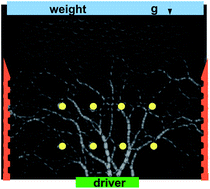Acoustic measurement of a granular density of modes
Abstract
In glasses and other disordered materials, measurements of the vibrational density of states reveal that an excess number of long-wavelength (low-frequency) modes, as compared to the Debye scaling seen in crystalline materials, is associated with a loss of mechanical rigidity. In this paper, we present a novel technique for measuring the density of modes (DOM) in a real granular material, in which we excite vibrational modes using white noise acoustic waves. The resulting vibrations are detected with piezoelectric sensors embedded inside a subset of the particles, from which we are able to compute the DOM via the spectrum of the velocity autocorrelation function, a technique previously applied in thermal systems. The velocity distribution for individual particles is observed to be Gaussian, but the ensemble distribution is non-Gaussian due to varying widths of the individual distributions. We find that the DOM exhibits several thermal-like features, including Debye scaling in a compressed hexagonally ordered packing, and an increase in low-frequency modes as the confining pressure is decreased. In disordered packings, we find that a characteristic frequency fc increases with pressure, but more weakly than has been observed in simulations of frictionless packings.


 Please wait while we load your content...
Please wait while we load your content...